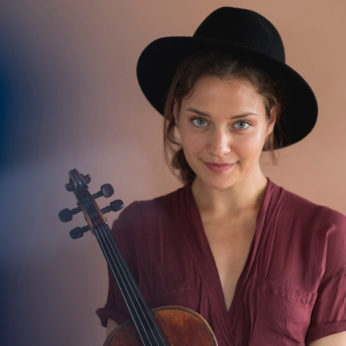Composer: Johannes Brahms (b. 1833 - d. 1897)
Performance date: 03/07/2022
Venue: Bantry House
Composition Year: 1875
Duration: 00:36:25
Recording Engineer: Eduardo Prado, Ergodos
Instrumentation: vn, va, vc, pf
Instrumentation Category:Piano Quartet/Piano Quintet
Artists:
Mairead Hickey -
[violin]
Dana Zemtsov -
[viola]
Ella van Poucke -
[cello]
Zoltán Fejérvári -
[Piano]

Mairéad Hickey [violin], Dana Zemtsov [viola], Ella van Poucke [cello], Zoltán Fejérvári [piano]
Johannes Brahms [1833-1897]
Piano Quartet No.3 in C minor Op.60 [1875]
1. Allegro non troppo
2. Scherzo: Allegro
3. Andante
4. Finale: Allegro comodo
On the cover you must have a picture, namely a head with a pistol to it. Now you can form some conception of the music! I’ll send you my photograph for the purpose. You can use a blue coat, yellow breeches and top-boats, since you seem to like colour-printing.
These were Brahms’ instructions to his publisher, Simrock, for the printing of the score of the C minor piano quartet. The man in the blue coat and yellow breeches is the archetypal Romantic hero, Werther, who shoots himself in the last chapter of Goethe’s novel because of his anguished and unrequited love for a married woman, whose husband he admires.
Brahms of course is talking about his relationship with Clara Schumann. The twenty years spent on the composition of this work began in Düsseldorf in 1853, when he was acting as Clara’s knight errant, while Robert was locked up in the sanatorium at Edenich. We shall never know why they never married after Robert’s death in 1856 – it seems that they were both so proud and independent that they felt their personal destinies were best worked out apart from each other – but their love never diminished. Most of Brahms’ music was composed for her, and she and the violinist Joachim would nearly always be the first people to see his scores. And though Clara was fourteen years older than Brahms, he survived her by less than a year, after she died in May 1896.
I speak in my music, wrote Brahms, and of no work is this truer than this quartet. The key of C minor was for Brahms, as for Beethoven, the key of intensity, drama and restlessness. The piano opens with a summons, to which the strings reply with a two-note phrase that speaks the name Clara, immediately followed by a transposed version of Schumann’s Clara-theme. This is repeated in B flat minor and the piano guides the music back to the dominant of C minor, which is tinged with a strange dissonance, a pizzicato E in the viola and violin. Joachim objected to this vehemently, but Brahms insisted on keeping it. I cannot part with the pizzicato E, the continuation will create the effect I want and allow the E to sound right.
A stormy transition leads to the richly romantic second subject, which gives rise to a small group of four variations. The third of these becomes massively vehement, and the last most ardently longing, leading us inevitably to a variant of the Clara-sigh, and thence straight into the development. This generates an enormously powerful theme, fortissimo and marcato, which is a direct offspring of the Clara-sigh that inevitably reappears after much intemperate raging. Joachim’s pizzicato also reappears, going in a new harmonic direction at the beginning of the recapitulation. The second subject is now given a wonderful translucent gloss until the third variation breaks the place up again. This leads to another bitter outburst in the coda, making the tranquillity of the final bars all the more unexpected.
There is some evidence that the scherzo was the finale of the original quartet written in 1856. Certainly it is through composed without a trio. The powerful rhythmic drive, which grows from the tense opening, is only interrupted by a brief chant-like second theme. The ending is brutally abrupt.
The Andante begins with one of Brahms’ most luxuriant cello melodies, growing into a rapt duet between the cello and the violin, which becomes a healing song of sorrow. There is a dolce second subject with a dangerously passionate side to it. The return of the main theme is in octaves in the piano, wondrously accompanied by pizzicati in cello and viola, before the cello reclaims his theme. The song returns, bringing peace, a mood which the hushed coda sustains.
The opening of the finale reminds us of the last movement of the G major Violin Sonata. Its relentless moto perpetuo quaver accompaniments are soon augmented into a powerful transition theme leading to a chorale-like second subject in the strings, with tongue-in-cheek responses from the piano. The transition theme and the chorale both generate a lot of Romantic fervour in the recapitulation, especially when the piano gets converted to the chorale theme. The final cadence is clearly Werther pulling the trigger.
Francis Humphrys
Copyright © 2025 West Cork Music. All rights reserved.
Designed and developed by Matrix Internet